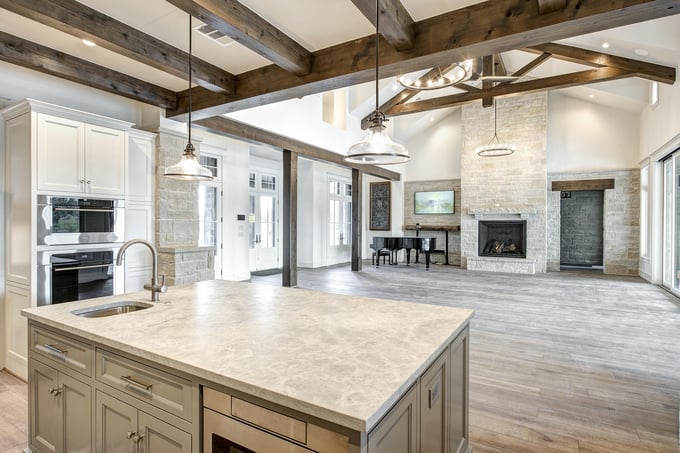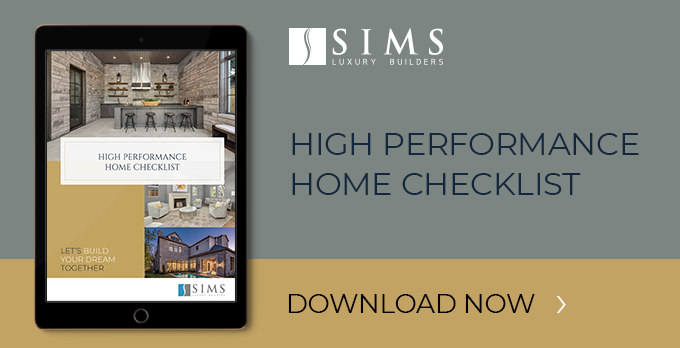.jpg?width=680&name=Photo%201%20(1).jpg)
As our collective consciousness shifts more and more towards minimizing the negative impact we make on our planet, there is a lot to consider when it comes to building and maintaining our homes.
When building custom, the good news is that you can control the energy efficiency of your future home. Unlike purchasing and retrofitting an existing home, you can build energy efficiency and high-performance features right into the design and construction of your new home.
But what is energy efficiency and home performance and why is it important? In this post, we will discuss what that means and review the current trends in green building. You’ll also learn a bit about the LEED certification program.
.jpg?width=680&name=Photo%202%20(1).jpg)
What Does It Mean to Be Green?
It’s actually easier to be green when you start from scratch. In today’s parlance, being green means using resources efficiently and coming up with new and better materials, methods, and technologies to increase the health of our homes and reduce our impact on the environment.
When you go green, you reduce your use of electricity, water, gas, and other natural resources. You take advantage of renewable energy sources from the sun, wind, and water. You reduce waste and pollution. When you reduce, reuse, and recycle, your carbon footprint is smaller, and you use fewer of the Earth's natural resources, both during construction and for the decades that follow.
Being green also means creating an indoor environment with healthy air quality. When you have efficient heating, air conditioning and ventilation, you reduce the buildup of particulate matter inside your home while using less energy to keep it comfortable.
Consider the environment in everything from the design to the construction to the operation and maintenance of your dream home. There are countless ways that you, your design partners, and your builder can take a conscientious approach to sustainability by safeguarding resources, minimizing waste, and maximizing use during the design and construction phases of your custom homebuilding journey.
.jpg?width=680&name=Photo%203%20(1).jpg)
Why Go Green?
There are many reasons to build an energy-efficient home, the most significant of those being: 1) ensuring the health and longevity of our home’s systems, 2) minimizing resources used, 3) decreasing utility and maintenance costs, and 4) improving indoor air quality.
The reason that hits closest to home (pardon the pun), is that building green can affect the health and quality of life for you and your family. High-performance home systems, when expertly installed and tested, can maintain the optimal balance of moisture, temperature, and ventilation while minimizing the presence of chemicals, suspended particles, and microbes in our indoor air. In addition, green building products are oftentimes manufactured using non-toxic, ethically-produced and sustainable materials and methods. This not only decreases the potentially harmful emissions in your home but also reduces your carbon footprint directly and indirectly.
When you design your house, take into consideration every phase of the home’s life cycle to reduce waste and advance the reuse of materials. Remember, at the end of its life, your home can still be green by providing material that can be recycled into new construction instead of sitting in a landfill.
Take a Holistic Approach to Green Building
Before diving into some specific trends, it’s important to first mention the following point. For each unique home design, there is an optimal way to integrate all systems in the home, and unfortunately there is a not a one-size-fits-all solution. Each home design is so unique that it will behave differently than any other. Sunlight will enter in different places at different times, heat and moisture will travel and get trapped in different ways, all materials will interact uniquely with the local climate and environment… the list goes on. That is why a holistic approach is needed to consider all of the unique mechanical systems, building methods, exterior and interior materials, technologies, and space configurations that are present in a specific home.
Be sure that your custom builder partners with an experienced energy and sustainability expert/certifier on all of their projects. And don’t wait until you have completed architectural plans and specifications before consulting a custom homebuilder. Get a builder involved early in the design phase in order to influence the energy-efficiency, performance, and constructability of your home’s design.
.jpg?width=680&name=Photo%204%20(1).jpg)
Energy-Efficient Home Design Trends
There are energy-efficient methods of construction and green materials for every aspect of your new home. You can go green in so many ways your head may spin! So let’s look at a few ways you can go green.
Building Envelope
Much of the energy efficiency of your home comes from the design of the envelope, or exterior, of the house.
- Select roofing materials and colors designed to reflect and re-emit heat from the sun. White and lightly colored roofing material, from asphalt shingles to metal and tile, reflect more heat than darker colors. You can also purchase materials with special pigments designed to re-emit additional heat away from the roof.
- Optimal levels and types of insulation in the walls and attic, along with your heat-reducing roof, help your home retain heat in the winter and keep cool in the hot, humid Houston summer.
- Ensuring the home is air-sealed prevents leakage of hot or cold air in and out of the house, which will work to reduce the load on your HVAC system.
- Like the roof, if you select light exterior colors for exterior walls, you can reflect and re-emit more heat from the sun’s rays. Exterior materials can also add another level of insulation to keep the indoor environment comfortable.
- Determining the number and placement of doors and windows also enhances air circulation and prevents drafts.
Besides the energy efficiency created by the proper materials, you can select many roofing, wall, and window materials from recyclables as well. Most metals, glass, and asphalt can be recycled into new building materials, as can some plastics. Choosing wood from forests where sustainable growth practices are used is another way to go green with your building envelope.
Heating, Cooling, and Ventilation
The biggest energy user in the American home is the HVAC system. Space heating and cooling take an enormous amount of energy, if the home is not designed well.
Using heat pumps, geothermal systems, sealed ductwork and smart thermostats and sensors are ways in which technology and construction come together to keep your home at a comfortable temperature with clean air. You can fine-tune your electricity use with a smart thermostat and even change the temperature settings when you aren’t home using an app on your phone.
Water Heating and Use
Tankless water heaters bring hot water closer to the faucet to reduce water waste while waiting for the hot water to come out. Energy to heat water can be obtained using natural gas or electricity, solar energy systems, or a hybrid of both.
Reduce water use further with smart sensors controlling the sprinkler systems, installing low-volume flush toilets, and finding ways to store rainwater for later use.
Appliances and Home Electronics
These days there are numerous energy-efficient systems to choose from and easier ways to identify them. Look for the Energy Star or other labeling indicating third-party review and classification of energy-efficient systems.
Many appliances are labeled with Energy Star or other designations, just like HVAC systems and other materials. High-efficiency appliances lower your electricity and water bill while cleaning and drying your clothes, keeping your food cold, and ensuring your stove keeps the appropriate temperature.
Automating your environmental controls for lighting and temperature means you don't have to be there to adjust it yourself. You can put everything on a schedule dedicated to lowering energy consumption, or you can control the environment with your smartphone or other device.
The growth of electronics in the home has increased the burden on the electrical grid and your wallet. Be aware of how much electricity is used daily to charge and run your electronic devices. Fortunately, the trend toward LED televisions and smaller devices that use less power have helped reduce overall electricity use.
Lighting
Lighting design plays a significant role in energy efficiency. Appropriate placement of windows, skylights, and lighting fixtures can increase natural light without increasing heat.
You have so many options for energy-efficient lighting. Along with energy- efficient windows, use shades and blinds to control the amount of light and heat entering the house at all times of the day. Use energy-efficient bulbs and lighting fixtures within the house to provide more lighting per watt than conventional bulbs. Not only do LED lights last longer, they also give off less heat. Your air conditioner will thank you.
Renewables
When you choose your electricity provider, you have a choice of companies that provide various percentages of energy from wind and solar farms. In some areas, you may also tap into geothermal heating.
In Texas, your HOA cannot legally prohibit placing solar panels on your roof. Shop for a type that works well with your roof style and keep the direction of the roof under consideration. Flat panels with no profile are becoming available. A southern or southwestern orientation is optimal for solar energy harvesting. You may even be able to sell excess electricity back to the grid or store it in a battery, depending on your system.

The LEED Program
LEED certification is a program from the US Green Building Council. It recognizes a project's efficiency standards and verifies environmental responsibility. LEED stands for Leadership in Energy and Environmental Design.
At the end of August, Sims completed a Texas Hill Country-style home for which we achieved a LEED Platinum certification, the highest certification offered. It is the first LEED Platinum home built in Fort Bend County just outside of Houston, Texas.
Compared to traditional construction, this home was designed and constructed using fewer resources and various techniques intended to reduce waste. We minimized environmental impact, decreased the lifecycle costs, and gave the homeowners the opportunity to have better health and productivity.
We use similar green building methods and materials in every home we build, but this house was exceptional. We are proud of the additional effort contributed by everyone to get this home certified.
Did you know there are fewer than 8,500 buildings in the world that have achieved LEED platinum certification? And this is one of them.
If you are interested in building an energy-efficient, environmentally friendly luxury home, give Sims Luxury Builders a call. We have the experience and the certification to prove it. We’re eager to help you achieve your dream home with a custom building journey that is both smooth and enjoyable.





COMMENT ON THIS ARTICLE